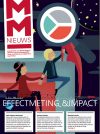Internet heeft de rol van word-of-mouth sterk vergroot: via internet bereikt de consument een veelheid van meningen die zijn consumentengedrag kunnen beïnvloeden. Bedrijven zijn zich meer en meer bewust van het belang van die via het internet verspreide meningen over hun producten. Sue MacDonald, marketing manager bij Nielsen BuzzMetrics, zette enige cijfers op een rij.
Whether theyre promoting arts organizations or selling the hottest new electronics gadget, marketers and advertisers have always known that word-of-mouth is the best form of advertising.
But until the advent of the internet, word-of-mouth influence was always difficult to measure, occurring as it did from one person to another, one singular conversation at a time. It was hard to measure, hard to control once it got out of hand, and equally hard to predict.
But the internet changed word-of-mouth behavior just as it changed so many other things in life. Indeed, the internet created not only a huge electronic shopping mall but also has evolved into a major, multi-media communications and research vehicle for consumers of every stripe. Before they attend a new museum exhibit, buy a new car or decide which brand of diaper to buy for their newborn babies, todays consumers (and arts patrons) often turn first to the internet, fire up a search engine, type in a few relevant keywords and begin pre-shopping. Search results in hand, they rely on the experiences, opinions and advice of other consumers who have also turned to the internet to document their experiences and offer helpful insights.
What does this have to do with word-of-mouth marketing? Everything, because the word-of-mouth recommendations that consumers used to share one at a time with friends, coworkers, neighbors and family members are now archived on thousands of internet forums, discussion boards, review/ratings web sites and blogs, where they provide a rich source of personal researchand where they leave a digital trail.
And because the trail is digital, modern-day technology can locate it, mine it and analyze it for rich, unsolicited market research. Pre-internet discussions shared privately or in small groups among friends now take place as rich, multi-media conversations in online art forums, entertainment blogs, niche discussion web sites and dedicated groups of like-minded consumers of everything from vintage automobiles to modern art and jazz.
Nielsen BuzzzMetrics, a U.S. company that discovers, measures and analyzes this online discussion for companies and brands, describes the phenomenon as consumer-generated media. Marketers and advertisers are accustomed to media measurement, based on circulation numbers, tv/radio ratings, advertising eyeballs and web-site clicks. Now, that same technology can be turned on the media that consumers themselves create, share and publicize freely on the internet.
Free services such as Buzzmetrics BlogPulse.com (http://www.blogpulse.com), for example, provide a window into a growing index of millions of blogs on every imagainable topic, from politics to knitting, movies to parenting, satire to celebrity gossip.
Increasingly, companies also are purchasing the services of such marketing intelligence firms to help them track what consumers are saying on the internet the good, the bad, the ugly, (and yes, even the rumors) and most importantly, the trusted. As Nielsen BuzzMetrics discovered in a 2004 survey of online users, consumers trust the advice and opinions of other consumers more than they trust traditional marketing and advertising.
And in a follow-up 2005 survey, 660 online users were asked to rank the factors or behaviors that influence their opinion about a product. Ranking first (7.72 index) was a positive word-of-mouth recommendation from another consumer, followed by a negative recommendation from another consumer (6.95 index) and a positive report from a trusted professional or expert (6.46). Ranking last were a tv/radio commercial (4.74) and an advertisement in a newspaper or magazine (4.63).
The trust factor alone is a major reason to pay attention to the influence of consumers who are active on the internet. Because the influence is growing, not only in number but in format. Todays consumer media creators are offering not only their words but their photos, images, first-person podcasts and mini-videos shot from digital cameras. Theyre creating an entire network of online media that contains valuable information issues, topics, sentiment, competitive data, demographics that todays savvy marketers and advertisers need to know in order to stay competitive.
If youre not paying attention, nows the time to start, and here are some tips from Nielsen BuzzMetrics:
start monitoring internet discussions now. Do it on your own using free search engines/services (Google/Yahoo/MSN search, BlogPulse.com, Technorati, or RSS-enabled news readers) or hire professionals to do it for you.
begin collecting feedback through existing tools. When consumers hit the contact us link on your web site, start asking in addition to standard demographic data how active they are on internet forums, which internet sources they rely on the most, and whether they create/publish their own opinions online (and where).
if it fits your mission, begin engaging in the conversations, but do so with transparency and honesty. Launch a blog or ask existing patrons to start an online forum on your behalf. Just remember: people active on the internet want the truth, not more marketing and advertising disguised as promotion. Make it real, and chances are, the followers will find you.
Auteur: Sue MacDonald marketing manager bij Nielsen BuzzMetrics sue.macdonald@buzzmetrics.com
